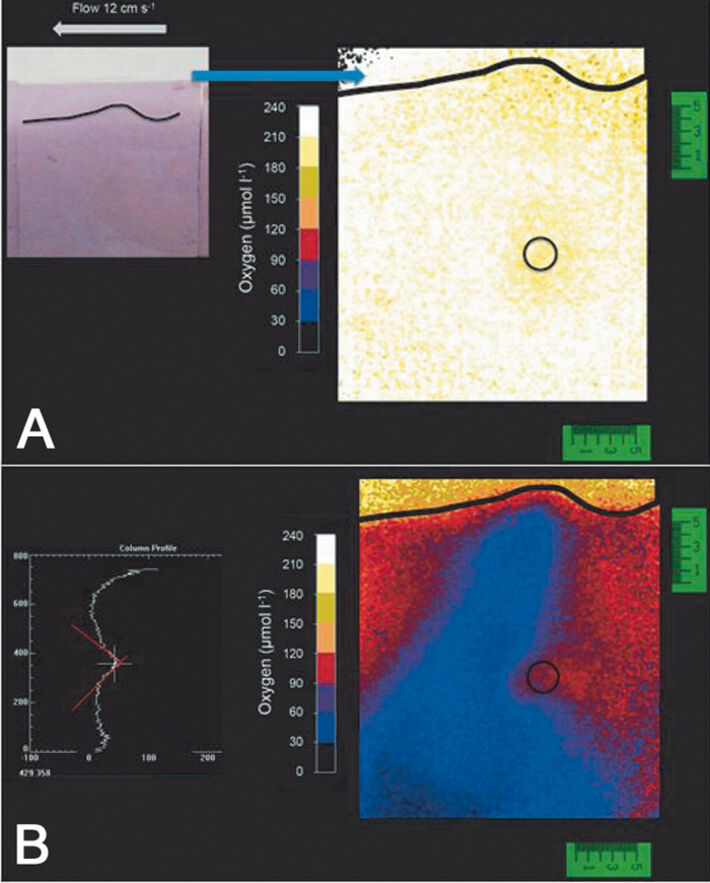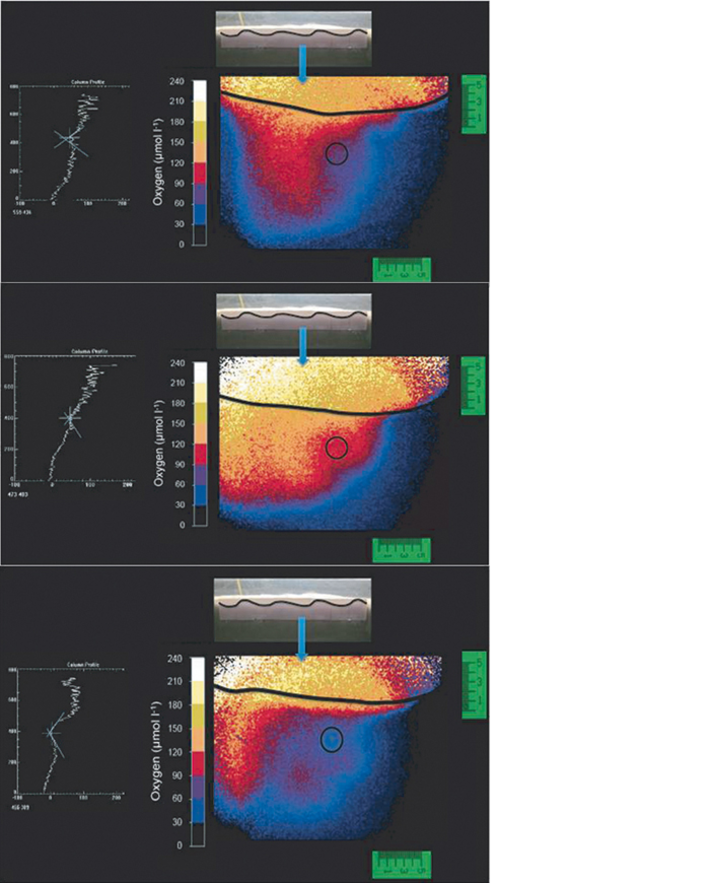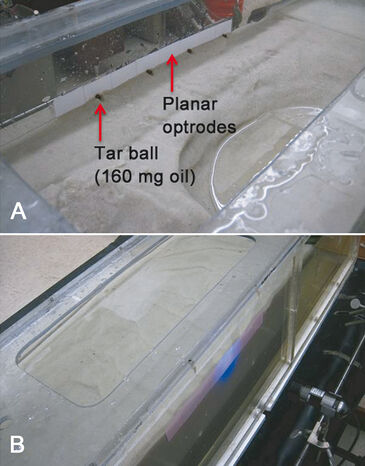Watch tutorials, webinars and informative videos about PreSens optical sensor systems.
Oxygen Dynamics around Buried Tar Balls in Florida Marine Sands
A laboratory flume study testing the VisiSensTM oxygen imaging system
Markus Huettel
Department of Earth, Ocean and Atmospheric Science, Florida State University, FL, USA
After the Deepwater Horizon accident in 2011, crude oil in unknown amounts was embedded in sandy shelf and shore sediments of the northeastern Gulf of Mexico. Oxygen is a key factor for microbial oil degradation. In a laboratory flume study the VisiSens system was applied to monitor oxygen dynamics around buried tar balls in Florida marine sands incubated with natural seawater. In the beginning the oxygen images showed sites of reduced oxygen consumption around the tar balls. However, within 6 days lower oxygen levels around the embedded oil were detected, revealing oxygen consumption by a microbial community, which had developed on and around the tar ball.
The Deepwater Horizon catastrophe has caused particular concern about the impact of the oil spill on marine ecosystems in the Gulf of Mexico. Oil was found in beach sediments as well as in sublittoral sands, where it still persists in unknown amounts. The sands on the West Florida Shelf are highly permeable (grain size approx. 250 µm), which allows water circulation through the upper layers of the sediment. This water exchange with the overlying water column can carry oxygen into the sediment allowing aerobic microbial oil degradation. On the other hand, buried oil may release toxic substances that can reduce microbial activities and thereby oxygen consumption. This study addresses the question whether pore water flows affect the dynamics of oxygen around embedded oil ("tar balls") and if these oxygen dynamics reflect aerobic oil degradation. A flume experiment was designed that used oxygen sensor foils and the VisiSens system to visualize the oxygen dynamics around small tar balls embedded in permeable Florida sand.
Materials & Methods
A sediment core (60 cm long, 30 cm wide, 20 cm deep) composed of sand from Pensacola Beach (FL) was incubated in a recirculating flume system with natural seawater (salinity 30, temperature 22 °C) that produced a water flow of 10 cm height and 12 cm s-1 discharge velocity over the sand. 8 planar optrode foils (Sensor Foil SF-RPSU4, PreSens), each measuring 4 x 4 cm were glued with silicone next to each other to the inner flume wall, such that each foil extended approx. 1 cm above the sediment surface. The optrodes were read out with the VisiSens camera (Detector Unit DU01, PreSens). 4 small tar balls (5 mm diameter, 5 mm long), each produced of 160 mg weathered Deepwater Horizon oil mixed with sand, were embedded at approx. 2 cm sediment depth, directly next to the sensor foils. An initial brief increase of the flow velocity to 30 cm s-1 produced ripples of approx. 1 cm amplitude.
The ripple topography was quantified using backlight illumination. Oxygen in the water was kept at 100 % air sat., monitored by an oxygen microsensor connected to a PreSens Microx TX3. The VisiSens camera was mounted on a rail paralleling the flume at a distance that allowed the depiction of one planar sensor foil. Moving the camera along the rail thus permitted a serial scanning of all 8 sensor foils. The oxygen sensor foils were calibrated using oxic and anoxic water. The oxygen in the sediment was manipulated by switching the flow in the flume on and off. Time series of individual sensor foils were combined with scans of all optrodes to assess the changes of the oxygen in the sediment around embedded oil over time. The raw pictures were evaluated with the VisiSens AnalytiCal 1 software.
Oxygen Dynamics around Tar Balls
After starting the flow in the flume, a general oxygen distribution developed with upwelling of anoxic pore water under ripple crests and down-welling of oxygen-rich water in ripple troughs. The time series (10 minute interval, 10 h duration) of sensor foil no. 5 showed that after the establishment of the flume sediment core, it took approx. 10 h to transport anoxic pore waters from deeper sediment layers to the sediment surface. Initially, the tar balls were sites of reduced oxygen consumption, likely due to toxic effects of the concentrated hydrocarbons released from the tar balls (Fig. 2 A). The tar ball was enclosed in a zone of higher oxygen concentration in the anoxic pore water plume drawn to the surface by the flow. Within 6 days of incubation in the flume a change in the oxygen profile could be observed, showing decreasing concentrations towards the tar ball (Fig. 2 B). After this period, a microbial community had developed on and around the tar balls that caused higher oxygen consumption rates compared to the surrounding sediment. In Fig. 3 the topography at sensor foil no. 5 had changed from a ripple to a trough and oxygenated water was pushed into the sediment. A high resolution time series was made with 2 s intervals using the VisiSens system. The buried tar produced a zone of lower oxygen concentration revealing higher consumption than in the surrounding sediment. In the repetition of this experiment a clear red halo showed around the tar ball. The oxygen profiles measured through the vertical plane cross sectioning the tar ball shows the zone affected over time. After 7 days, the embedded tar had produced a layer of enhanced oxygen consumption due to the release of hydrocarbons that provided microbial food, though the slopes were reduced.


Conclusion
Oxygen is a key factor for microbial oil degradation. The visualization of oxygen dynamics over time with the VisiSens system opened the opportunity for a new approach. The plug & play system allowed to go right ahead and take first test measurements. Though the system was not suitable for field recordings as of its sensitivity to ambient light, its application in the flume and time series measurement gave a good overview of the time frame in which a microbial community forms around buried oil and how oxic and anoxic water flows through the permeable sands can influence microbial oil degradation. As chemical optical sensor systems can also be used in high pressure environments this system might be an interesting option for deep sea research.



